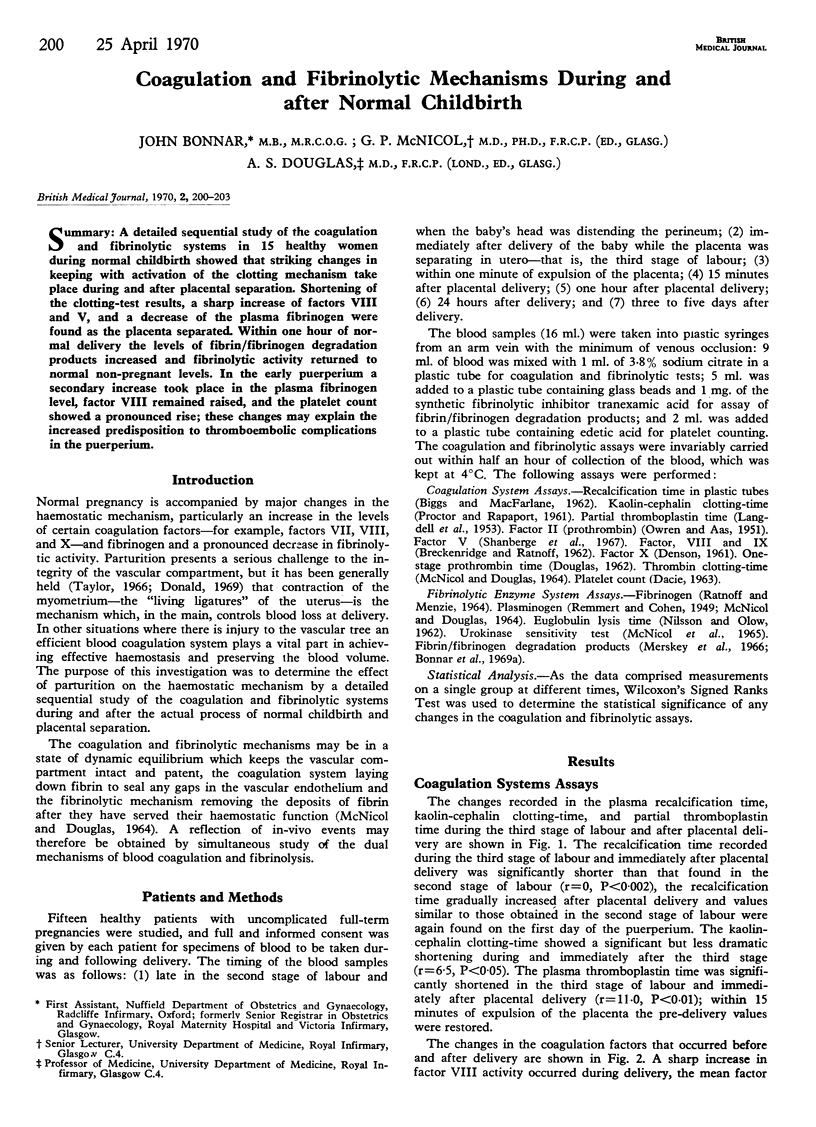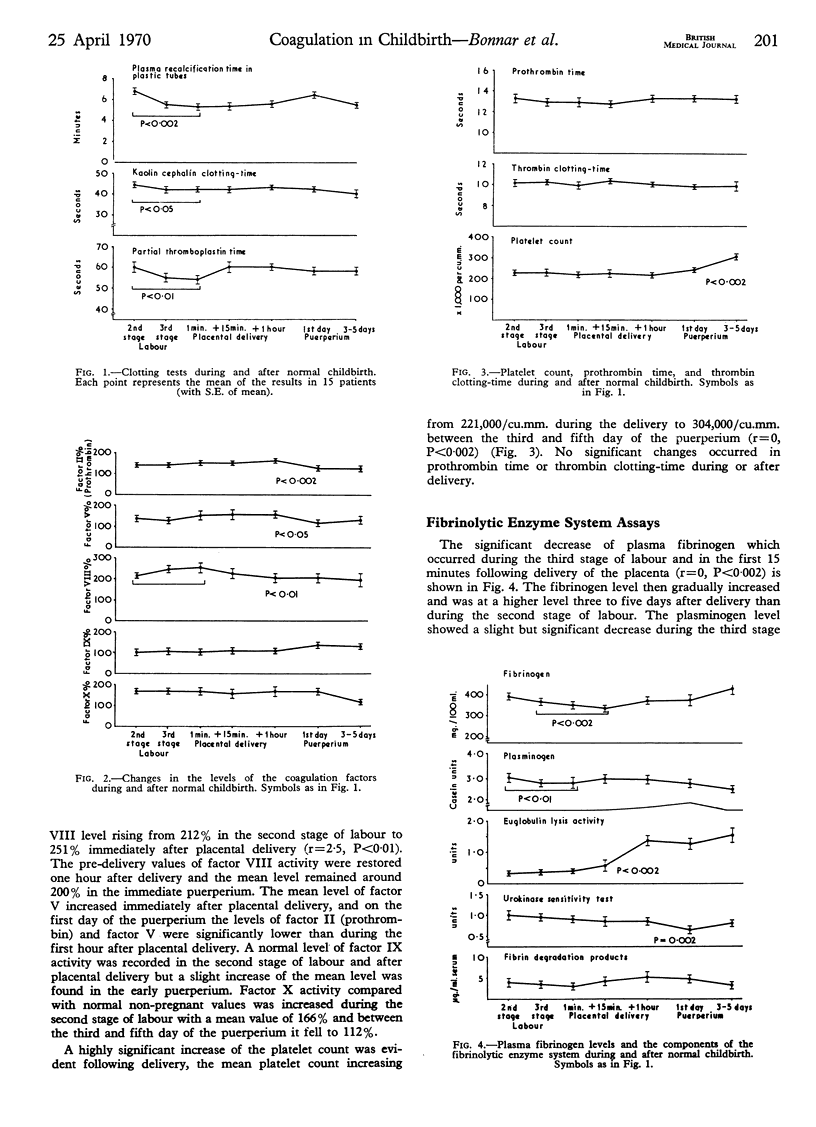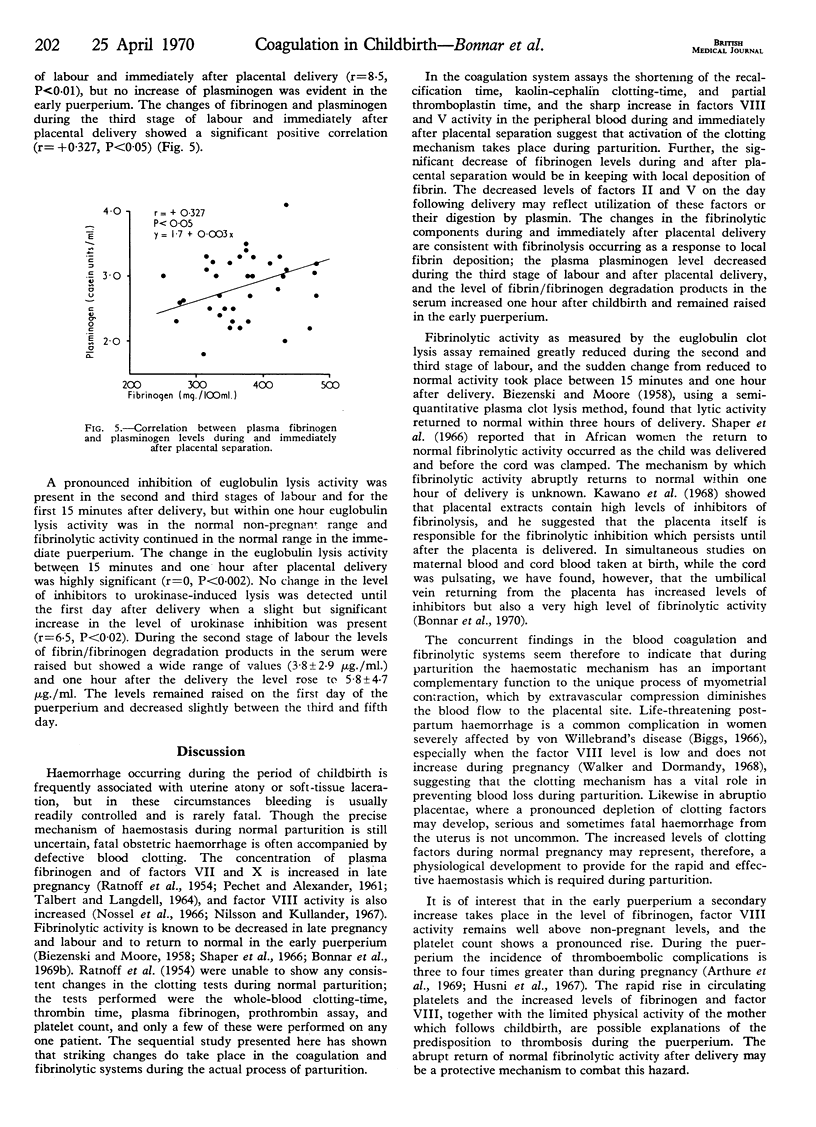Abstract
A detailed sequential study of the coagulation and fibrinolytic systems in 15 healthy women during normal childbirth showed that striking changes in keeping with activation of the clotting mechanism take place during and after placental separation. Shortening of the clotting-test results, a sharp increase of factors VIII and V, and a decrease of the plasma fibrinogen were found as the placenta separated. Within one hour of normal delivery the levels of fibrin/fibrinogen degradation products increased and fibrinolytic activity returned to normal non-pregnant levels. In the early puerperium a secondary increase took place in the plasma fibrinogen level, factor VIII remained raised, and the platelet count showed a pronounced rise; these changes may explain the increased predisposition to thromboembolic complications in the puerperium.
Full text
PDF



Selected References
These references are in PubMed. This may not be the complete list of references from this article.
- BIEZENSKI J. J., MOORE H. C. Fibrinolysis in normal pregnancy. J Clin Pathol. 1958 Jul;11(4):306–310. doi: 10.1136/jcp.11.4.306. [DOI] [PMC free article] [PubMed] [Google Scholar]
- BRECKENRIDGE R. T., RATNOFF C. D. Studies on the nature of the circulating anticoagulant directed against antihemophilic factor: with notes on an assay for anthemophilic factor. Blood. 1962 Aug;20:137–149. [PubMed] [Google Scholar]
- Bonnar J., Davidson J. F., Pidgeon C. F., McNicol G. P., Douglas A. S. Fibrin degradation products in normal and abnormal pregnancy and parturition. Br Med J. 1969 Jul 19;3(5663):137–140. doi: 10.1136/bmj.3.5663.137. [DOI] [PMC free article] [PubMed] [Google Scholar]
- Bonnar J., McNicol G. P., Douglas A. S. Fibrinolytic enzyme system and pregnancy. Br Med J. 1969 Aug 16;3(5667):387–389. doi: 10.1136/bmj.3.5667.387. [DOI] [PMC free article] [PubMed] [Google Scholar]
- DENSON K. W. The specific assay of Prower-Stuart factor and factor VII. Acta Haematol. 1961 Feb;25:105–120. doi: 10.1159/000206523. [DOI] [PubMed] [Google Scholar]
- Husni E. A., Pena L. I., Lenhert A. E. Thrombophlebitis in pregnancy. Am J Obstet Gynecol. 1967 Apr 1;97(7):901–905. doi: 10.1016/0002-9378(67)90514-5. [DOI] [PubMed] [Google Scholar]
- Kawano T., Morimoto K., Uemura Y. Urokinase inhibitor in human placenta. Nature. 1968 Jan 20;217(5125):253–254. doi: 10.1038/217253a0. [DOI] [PubMed] [Google Scholar]
- LANGDELL R. D., WAGNER R. H., BRINKHOUS K. M. Effect of antihemophilic factor on one-stage clotting tests; a presumptive test for hemophilia and a simple one-stage antihemophilic factor assy procedure. J Lab Clin Med. 1953 Apr;41(4):637–647. [PubMed] [Google Scholar]
- MCNICOL G. P., BARAKAT A. A., DOUGLAS A. S. PLASMA FIBRINOLYTIC ACTIVITY IN RENAL DISEASE. Scott Med J. 1965 May;10:189–194. doi: 10.1177/003693306501000502. [DOI] [PubMed] [Google Scholar]
- Merskey C., Kleiner G. J., Johnson A. J. Quantitative estimation of split products of fibrinogen in human serum, relation to diagnosis and treatment. Blood. 1966 Jul;28(1):1–18. [PubMed] [Google Scholar]
- Nilsson I. M., Kullander S. Coagulation and fibrinolytic studies during pregnancy. Acta Obstet Gynecol Scand. 1967;46(3):273–285. doi: 10.3109/00016346709158632. [DOI] [PubMed] [Google Scholar]
- Nossel H. L., Lanzkowsky P., Levy S., Mibashan R. S., Hansen J. D. A study of coagulation factor levels in women during labour and in their newborn infants. Thromb Diath Haemorrh. 1966 Jul 31;16(1):185–197. [PubMed] [Google Scholar]
- OWREN P. A., AAS K. The control of dicumarol therapy and the quantitative determination of prothrombin and proconvertin. Scand J Clin Lab Invest. 1951;3(3):201–208. doi: 10.3109/00365515109060600. [DOI] [PubMed] [Google Scholar]
- PECHET L., ALEXANDER B. Increased clotting factors in pregnacy. N Engl J Med. 1961 Nov 30;265:1093–1097. doi: 10.1056/NEJM196111302652205. [DOI] [PubMed] [Google Scholar]
- PROCTOR R. R., RAPAPORT S. I. The partial thromboplastin time with kaolin. A simple screening test for first stage plasma clotting factor deficiencies. Am J Clin Pathol. 1961 Sep;36:212–219. doi: 10.1093/ajcp/36.3.212. [DOI] [PubMed] [Google Scholar]
- RATNOFF O. D., COLOPY J. E., PRITCHARD J. A. The blood-clotting mechanism during normal parturition. J Lab Clin Med. 1954 Sep;44(3):408–415. [PubMed] [Google Scholar]
- REMMERT L. F., COHEN P. P. Partial purification and properties of a proteolytic enzyme of human serum. J Biol Chem. 1949 Nov;181(1):431–448. [PubMed] [Google Scholar]
- Shaper A. G., Macintosh D. M., Kyobe J. Fibrinolytic activity in pregnancy, during parturition, and in the puerperium. Lancet. 1966 Oct 22;2(7469):874–876. doi: 10.1016/s0140-6736(66)91976-3. [DOI] [PubMed] [Google Scholar]
- TALBERT L. M., LANGDELL R. D. NORMAL VALUES OF CERTAIN FACTORS IN THE BLOOD CLOTTING MECHANISM IN PREGNANCY. Am J Obstet Gynecol. 1964 Sep 1;90:44–50. doi: 10.1016/s0002-9378(16)34890-6. [DOI] [PubMed] [Google Scholar]
- Walker E. H., Dormandy K. M. The management of pregnancy in Von Willebrand's disease. J Obstet Gynaecol Br Commonw. 1968 Apr;75(4):459–463. doi: 10.1111/j.1471-0528.1968.tb00144.x. [DOI] [PubMed] [Google Scholar]


